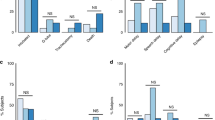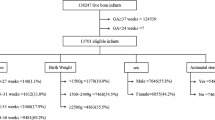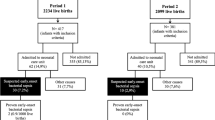Abstract
OBJECTIVES:
(1) To determine the incidence and the time course of elevated temperature following delivery in term infants with clinical chorioamnionitis (CHORIO) and (2) to determine if the extent of temperature elevation at birth is associated with increased likelihood of NICU Admissions, birth depression, or with short-term neurological abnormalities.
DESIGN/METHODS:
The infants were divided into two groups based on the median admission rectal temperature of 37.8°C for the cohort. Depression at birth was defined as either the need of positive pressure ventilation for >2 minutes, intubation, or Apgar score <6 at 5 minutes. Neurological examination and assessment of encephalopathy (Sarnat staging) was performed at birth and daily thereafter, by one investigator blinded to temperature findings.
RESULTS:
Infants with higher rectal temperature at 30 minutes of life were more likely to be admitted to NICU: OR (2.8, 95% confidence interval (CI) [1.8 to 4.3]), and were more likely to have birth depression OR (3, 95%CI [1.4 to 6.5]). For infants in NICU, a rectal temperature above 37.8°C was present in 87% in the delivery room, persisted in 47% at 30 minutes, and declined to a normal temperature at 60 minutes of life in the absence of medical interventions. There was no relationship between neurological scores and neonatal temperature.
CONCLUSIONS:
Term infants exposed to CHORIO who had a higher neonatal temperature at 30 minutes of life, were more likely to be admitted to the NICU and to have birth depression, than infants with lesser degree of temperature elevation after birth. Within the NICU group, the extent of temperature elevation was not associated with worse neurological outcomes.
This is a preview of subscription content, access via your institution
Access options
Subscribe to this journal
Receive 12 print issues and online access
$259.00 per year
only $21.58 per issue
Buy this article
- Purchase on Springer Link
- Instant access to full article PDF
Prices may be subject to local taxes which are calculated during checkout

Similar content being viewed by others
References
Lieberman E, Eichenwald E, Mathur G, Richardson D, Heffner L, Cohen A . Intrapartum fever and unexplained seizures in term infants. Pediatrics 2000;106:983–988.
Lieberman E, Lang J, Richardson DK, Frigoletto FD, Heffner LJ, Cohen A . Intrapartum maternal fever and neonatal outcome. Pediatrics 2000;105:8–13.
Petrova A, Demissie K, Rhoads GG, Smulian JC, Marcella S, Ananth CV . Association of maternal fever during labor with neonatal and infant morbidity and mortality. Obstet Gynecology 2001;98:20–27.
Nelson KB, Grether JK . Potentially asphyxiating conditions and spastic cerebral palsy in infants of normal birth weight. Am J Obstet Gynecol 1998;179:507–513.
Wu YW, Escobar GJ, Grether JK, Croen LA, Greene JD, Newman TB . Chorioamnionitis and cerebral palsy in term and near-term infants. JAMA 2003;290:2677–2684.
Wu YW, Colford Jr JM . Chorioamnionitis as a risk factor for cerebral palsy: a meta-analysis. JAMA 2000;284:1417–1424.
Minamisawa H, Smith ML, Siesjo BK . The effect of mild hyperthermia and hypothermia on brain damage following 5, 10, and 15 minutes of forebrain ischemia. Ann Neurol 1990;28:26–33.
Cunningham FG, Mac Donald PC, Gant NF, Leveno 0KJ, Gilstrap LC . Williams Obstetrics, 19th ed., Chapter 38, McGraw-Hill, USA; 1993. p. 863.
Shalak LF, Laptook AR, Jafri HS, Ramilo O, Perlman JM . Clinical chorioamnionitis, elevated cytokines, and brain injury in term infants. Pediatrics 2002;110:673–680.
Dubowitz LM, Dubowitz V, Goldberg C . Clinical assessment of gestational age in the newborn infant. J Pediatr 1970;77:1–10.
Sarnat HB, Sarnat MS . Neonatal encephalopathy following fetal distress. A clinical and electroencephalographic study. Arch Neurol 1976;33:696–705.
Manroe BL, Weinberg AG, Rosenfeld CR, Browne R . The neonatal blood count in health and disease. I. Reference values for neutrophilic cells. J Pediatric 1979;95:89–98.
Salafia CM, Weigl C, Silberman L . The prevalence and distribution of acute placental inflammation in uncomplicated term pregnancies. Obstet Gynecol 1989;73:383–389.
Kim Y, Busto R, Dietrich WD, Kraydieh S, Ginsberg MD . Delayed postischemic hyperthermia in awake rats worsens the histopathological outcome of transient focal cerebral ischemia. Stroke 1999;27 (12):2274–2280.
Perlman J . Maternal fever and neonatal depression: preliminary observations. Clin Pediatr 1999;38:287–291.
Kuipers IM, Maertzdorf WJ, De Jong DS, Hanson MA, Blanco CE . Initiation and maintenance of continuous breathing at birth. Pediatr Res 1997;42:163–168.
Lieberman E, O'donoghue C . Unintended effects of epidural analgesia during labor: a systematic review. Am J Obstet Gynecol 2002;186:S31–S68.
Macaulay J, Bond K, Steer P . Epidural analgesia in labor and fetal hyperthermia. Obstet Gynecol 1992;80:665–669.
Schroder HJ, Power GG . Engine and radiator: fetal and placental interactions for heat dissipation. Exp Physiol 1997;82:403–414.
Walker DW, Davies AN . Effects of hyperthermia on fetal breathing movements. J Dev Physiol 1986;8:485–497.
Walker DW . Effects of increased core temperature on breathing movements and electro cortical activity in fetal sheep. J Dev Physiol 1988;10:513–523.
Walker DW, Wood C . Temperature relationship of the mother and fetus during labor. Am J Obstet Gynecol 1970;107:83–87.
Smulian JC, Bhandari V, Vintzileos AM, et al. Intrapartum fever at term: serum and histologic markers of inflammation. Am J Obstet Gynecol 2003;188:269–274.
AAP/ACOG. Guidelines for Perinatal Care, 4th ed., Chapter 5, AAP/ACOG, USA 1997. p. 122.
Author information
Authors and Affiliations
Rights and permissions
About this article
Cite this article
Shalak, L., Perlman, J., Jackson, G. et al. Depression at Birth in Term Infants Exposed to Maternal Chorioamnionitis: Does Neonatal Fever Play a Role?. J Perinatol 25, 447–452 (2005). https://doi.org/10.1038/sj.jp.7211326
Published:
Issue Date:
DOI: https://doi.org/10.1038/sj.jp.7211326
This article is cited by
-
Suspected clinical chorioamnionitis with peak intrapartum temperature <380C: the prevalence of confirmed chorioamnionitis and short term neonatal outcome
BMC Pediatrics (2022)
-
The role of fetal inflammatory response syndrome and fetal anemia in nonpreventable term neonatal encephalopathy
Journal of Perinatology (2016)



